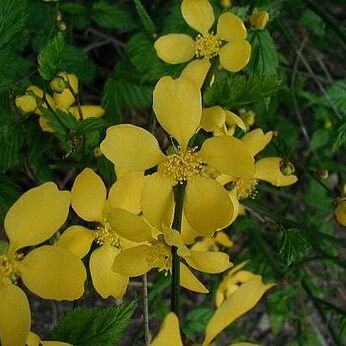Shrubs, ?spreading?, open, rounded, 10–20(–30) dm; ?rhizomatous, suckering freely?. Stems 1–30+, widely arcuate, ?sparingly branched?; bark (periderm) not forming, epidermis green, ?striate, glabrous?; short shoots absent; unarmed; ?bud scales imbricate?. Leaves winter-deciduous, cauline, alternate; stipules caducous, linear-subulate, ?thin?, margins entire ?± strigose-ciliate?; petiole present; blade ovate to lance-ovate, 2–8.5 cm, membranous, margins flat, coarsely doubly serrate, abaxial surface sparsely sericeous-strigose along veins. Inflorescences terminal ?on vernal, leaf-bearing lateral branches?, flowers solitary, sparsely strigose or glabrous; bracts absent; bracteoles absent or present, ?leaflike?. Pedicels present. Flowers 20–50 mm diam.; epicalyx bractlets 0; hypanthium saucer-shaped, 3–4 mm diam., glabrous; sepals (4 or)5(or 6), spreading to reflexed, oblong-ovate to ± orbiculate; petals (4 or)5(or 6), to 34 in multi-petaled cultivars, ?spreading?, strong yellow to slightly orangish or yellow-cream (some petals white in multi-petaled cultivars), oblong-ovate to orbiculate, ?base short-clawed, apex rounded to emarginate?; stamens 80–130 (0 or few in multi-petaled cultivars), shorter than petals; torus absent; carpels (4–)5(–8), ?globose?, glabrous, styles lateral, ?linear, ± exceeding filaments?; ovules 2. Fruits aggregated nutlets, (1–)5 in 1 whorl, tan, obliquely obovoid-globose, 4.5–5 mm, ?with distinct adaxial ridge?, glabrous except for coarse basal hypanthial hairs; hypanthium persistent; sepals persistent (withering), reflexed; ?exocarp thin, wrinkled, mesocarp thin, dry, endocarp ± cartilaginous?. x = 9.
More
Shrubs deciduous. Branchlets virgate, arising from scaly buds, slender. Leaves alternate; stipules linear-subulate, caducous; leaf blade simple, margin doubly serrate. Flowers terminal on lateral branchlets, solitary, large, bisexual. Hypanthium shortly saucer-shaped, flat. Sepals 5, valvate. Petals 5, yellow, base shortly clawed. Stamens numerous, in several series. Carpels 5, free, included in hypanthium; ovules 2, laterally attached to middle of suture, 1 abortive; style apical, erect, filiform, apex truncate. Fruit an achene, laterally compressed, glabrous. x = 9.

